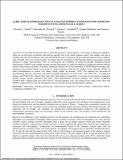Files in this item
Label-free haemogram using wavelength modulated Raman spectroscopy for identifying immune-cell subset
Item metadata
| dc.contributor.author | Ashok, P.C. | |
| dc.contributor.author | Praveen, B.B. | |
| dc.contributor.author | Campbell, E.C. | |
| dc.contributor.author | Dholakia, K. | |
| dc.contributor.author | Powis, S.J. | |
| dc.contributor.editor | Mahadevan-Jansen, Anita | |
| dc.contributor.editor | Petrich, Wolfgang | |
| dc.date.accessioned | 2014-09-02T11:31:01Z | |
| dc.date.available | 2014-09-02T11:31:01Z | |
| dc.date.issued | 2014-03-04 | |
| dc.identifier | 145282793 | |
| dc.identifier | eda1882c-3eed-499d-82b4-bcd10a1fde30 | |
| dc.identifier | 84897458690 | |
| dc.identifier | 000334098200004 | |
| dc.identifier.citation | Ashok , P C , Praveen , B B , Campbell , E C , Dholakia , K & Powis , S J 2014 , Label-free haemogram using wavelength modulated Raman spectroscopy for identifying immune-cell subset . in A Mahadevan-Jansen & W Petrich (eds) , Biomedical Vibrational Spectroscopy VI : Advances in Research and Industry . vol. 8939 , Proceedings of SPIE , vol. 8839 , SPIE . https://doi.org/10.1117/12.2039836 | en |
| dc.identifier.isbn | 9780819498526 | |
| dc.identifier.issn | 1605-7422 | |
| dc.identifier.other | ORCID: /0000-0003-4218-2984/work/60195295 | |
| dc.identifier.uri | https://hdl.handle.net/10023/5323 | |
| dc.description | The authors thank the UK EPSRC the CR-UK/EPSRC/MRC/DoH (England) imaging Program and the European Union project FAMOS (FP7 ICT, contract no. 317744) for funding, K.D. is a Royal Society-Wolfson Merit Award Holder. | en |
| dc.description.abstract | Leucocytes in the blood of mammals form a powerful protective system against a wide range of dangerous pathogens. There are several types of immune cells that has specific role in the whole immune system. The number and type of immune cells alter in the disease state and identifying the type of immune cell provides information about a person's state of health. There are several immune cell subsets that are essentially morphologically identical and require external labeling to enable discrimination. Here we demonstrate the feasibility of using Wavelength Modulated Raman Spectroscopy (WMRS) with suitable machine learning algorithms as a label-free method to distinguish between different closely lying immune cell subset. Principal Component Analysis (PCA) was performed on WMRS data from single cells, obtained using confocal Raman microscopy for feature reduction, followed by Support Vector Machine (SVM) for binary discrimination of various cell subset, which yielded an accuracy >85%. The method was successful in discriminating between untouched and unfixed purified populations of CD4+CD3+ and CD8+CD3+ T lymphocyte subsets, and CD56+CD3- natural killer cells with a high degree of specificity. It was also proved sensitive enough to identify unique Raman signatures that allow clear discrimination between dendritic cell subsets, comprising CD303+CD45+ plasmacytoid and CD1c+CD141+ myeloid dendritic cells. The results of this study clearly show that WMRS is highly sensitive and can distinguish between cell types that are morphologically identical. | |
| dc.format.extent | 8 | |
| dc.format.extent | 513865 | |
| dc.language.iso | eng | |
| dc.publisher | SPIE | |
| dc.relation.ispartof | Biomedical Vibrational Spectroscopy VI | en |
| dc.relation.ispartofseries | Proceedings of SPIE | en |
| dc.subject | QC Physics | en |
| dc.subject.lcc | QC | en |
| dc.title | Label-free haemogram using wavelength modulated Raman spectroscopy for identifying immune-cell subset | en |
| dc.type | Conference item | en |
| dc.contributor.sponsor | European Commission | en |
| dc.contributor.institution | University of St Andrews. School of Physics and Astronomy | en |
| dc.contributor.institution | University of St Andrews. School of Biology | en |
| dc.contributor.institution | University of St Andrews. School of Medicine | en |
| dc.contributor.institution | University of St Andrews. Biomedical Sciences Research Complex | en |
| dc.identifier.doi | https://doi.org/10.1117/12.2039836 | |
| dc.identifier.grantnumber | 317744 | en |
This item appears in the following Collection(s)
Items in the St Andrews Research Repository are protected by copyright, with all rights reserved, unless otherwise indicated.

